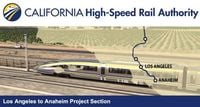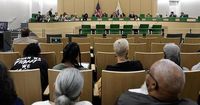California has always been a state of grand ambitions, and nowhere is this more evident than in its ongoing quest to build America’s first true high-speed rail system. From the Gold Rush to the postwar boom, the Golden State has long prided itself on doing things bigger, faster, and—at least in the past—better than anywhere else. But as the saga of the California High-Speed Rail project unfolds, it’s clear that even the state’s legendary can-do spirit is being tested by the sheer scale and complexity of this undertaking.
The vision for California’s bullet train dates back to 1979, when then-Governor Jerry Brown first floated the idea of connecting Los Angeles and San Francisco by high-speed rail. Inspired by the sleek trains of Japan and Western Europe, Brown saw the project as both an environmental necessity and a social good—a way to get cars off the roads, cut down on pollution, and offer Californians a fast, comfortable alternative to the grind of Interstate 5 or the hassle of airport security. “Climb aboard the bullet train, relax in plush seats, enjoy five-star dining, and be in San Francisco in two hours,” was the dazzling promise, according to the Fullerton Observer.
For decades, however, the bullet train remained just that—a promise. Funding woes, environmental concerns, and shifting political winds meant that little real progress was made. The 1990s saw the creation of the Intercity High-Speed Rail Commission and, later, the California High-Speed Rail Authority (CHSRA), but the project languished in the planning stages. It wasn’t until 2008 that things seemed to turn a corner: Proposition 1A, which authorized $9 billion in bonds for the project (plus another $950 million for connecting commuter lines), passed with 52.6% of the vote. The measure required that state funds be matched by federal dollars, and supporters ranged from business groups to labor unions to most Democrats. Even then, skepticism was brewing among fiscal conservatives and a wary public, who questioned the rosy cost estimates and grandiose claims.
When ground was finally broken in 2015, hopes were high. The first segment, in the flat farmlands of the San Joaquin Valley, seemed straightforward enough. The High-Speed Rail Authority touted the creation of more than 15,300 good-paying construction jobs, most of them for Central Valley residents—a significant boost for a region often left behind in the state’s economic booms. But as of 2025, not one mile of track has been laid for passenger service, and the project’s trajectory has veered far from its original path.
“Since the start of high-speed rail construction, the project has created more than 15,300 good paying construction jobs, a majority going to residents of the Central Valley,” the Authority continues to emphasize in its communications. Yet billions have been spent, and the so-called “gravy train” has become a lightning rod for criticism from both sides of the political aisle.
Federal support has waxed and waned with changing administrations. In May 2019, the Trump administration announced it would withhold nearly $1 billion in federal funds, citing missed deadlines and a shift in focus from connecting Los Angeles and San Francisco to a more modest goal: linking Bakersfield and Merced in the San Joaquin Valley. Under President Biden, the money flowed again—$3.1 billion in new federal funds brought the total to nearly $7 billion since 2009. But the pendulum swung back in 2025, when President Trump returned to office. In February, he called for a federal audit of the project; by June, Secretary of Transportation Sean Duffy released a scathing report.
“I promised the American people we would be good stewards of their hard-earned tax dollars. This report exposes a cold, hard truth: CHSRA has no viable path to complete this project on time or on budget. CHSRA is on notice—if they can’t deliver on their end of the deal, it could be time for these funds to flow to other projects that can achieve President Trump’s vision of building great, big, beautiful things again. Our country deserves high-speed rail that makes us proud—not boondoggle trains to nowhere,” Duffy declared, as quoted by the Fullerton Observer.
In July 2025, the federal government canceled $4 billion in unspent funding allocated by the Federal Railroad Administration. Duffy even raised the possibility that Washington could demand California repay the nearly $7 billion already spent, arguing that the CHSRA failed to meet the requirements of its original funding agreement. Now, California officials are scrambling to come up with a new funding plan. It’s estimated that just finishing the San Joaquin Valley segment will require another $14 billion—and may not be completed until the early 2030s.
The numbers are staggering. Back in 2008, the entire Los Angeles to San Francisco line was projected to cost $33 billion and be operational by 2028. Today, the CHSRA estimates the full system could cost $135 billion, with completion pushed into the late 2030s or even 2040s. Critics warn the final price tag could be double that. The delays and overruns have become a cautionary tale, especially when compared to the feats of the past. The Transcontinental Railroad, built in the 1860s, spanned 1,800 miles of rugged terrain and was completed in just four years. “Here we are a century and a half later, and California can’t seem to build a train from Bakersfield to Modesto, let alone from Los Angeles to San Francisco,” the Fullerton Observer noted, with a hint of exasperation.
Amidst the setbacks, the High-Speed Rail Authority is pressing on. On September 3, 2025, it will host a virtual community meeting to update the public on the Los Angeles to Anaheim (LA-A) Project Section—a roughly 30-mile corridor connecting Los Angeles Union Station to the Anaheim Regional Transportation Intermodal Center. According to the Authority’s outreach team, the meeting will cover the LA-A Preferred Alternative, grade separations, future stations, Metrolink relocations, maintenance facility options, and local safety improvements. The Authority is finalizing technical studies and expects to release the Draft Environmental Impact Report/Environmental Impact Statement by late 2025. The meeting will also guide the public on how to participate in the comment process once the draft is published.
“We look forward to your continued involvement and partnership as we advance the Los Angeles to Anaheim Project Section,” the Authority’s Southern California Outreach Team said in an open invitation, as reported by the Fullerton Observer. The event will be accessible online, with interpretation in Spanish and Korean, and is part of the Authority’s ongoing efforts to keep the public engaged and informed.
For all the frustration and finger-pointing, the project remains a symbol of California’s ambition—and its challenges. Whether the bullet train will ever zip passengers from Los Angeles to San Francisco in two hours, as once promised, is an open question. But for now, the state’s high-speed rail dream rolls on, fueled by hope, controversy, and the enduring belief that California can still do big things—if it can just get out of its own way.

